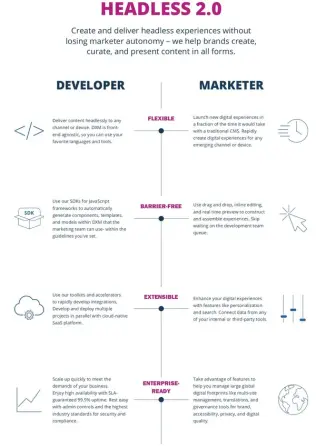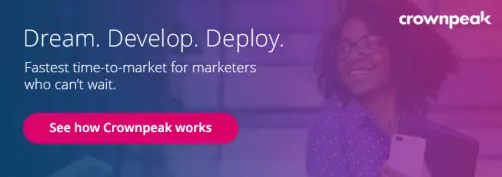Finding a Future-Proof Approach to Headless CMS

Growing customer demand for omnichannel digital experiences is driving digital transformation across multiple industries and disciplines. According to Gartner , 74% of customer experience leaders anticipated that their organizational CX budgets would increase in 2020. This is due, in large part, to their understanding of the connection between better CX and better business outcomes.
Now, delivering excellent, omnichannel customer experience is seen, not as a nice-to-have, but as a necessity for organizations looking to achieve their market goals. The drive toward digital may be prompted by customer demand. But it is marketers who face the significant challenge of delivering on the promise of better, faster, and more immersive digital experiences .
Channel proliferation challenges content marketers
Marketers have benefitted from the development of a wide range of methods for delivering digital experiences to their intended audience. At the same time, however, the proliferation of channels for delivering content has posed several challenges. The demand for device types, channels, customer preferences, and frequency of touchpoint has increased. So has the complexity of technology, content, and operations to meet that demand.
In addition to the increasing use of new formats and devices for content delivery, the content itself has become increasingly sophisticated. Consumers now demand more personalized and immersive online experiences.
The need to create marketing material that matches consumer expectations has resulted in the creation of more and more ambitious multimedia content. For companies held back by legacy CMS solutions, it can take huge technical effort to stand up new channels. Frequently this occurs while simultaneously giving up the ability to properly preview and in-line edit those experiences. Organizations feel their responsiveness and agility draining away with each new channel. All the while, they're still not able to use the most advanced capabilities of the platform since those only work on the web.
The rise of headless CMS
As marketing’s demands to respond rapidly and create great multi-channel experiences increased, developers found that legacy CMS tools were eroding their ability to execute. Creating a new experience means more back-end coding, more complexity needed to manage during upgrades, and more servers that needed to be administrated. Perhaps worse, they needed specialized developer skills specific to their platform and found that they were building applications, not digital experiences . Most of the code was back-end C# or Java code, not front-end HTML or JavaScript.
Headless solutions were developed to solve this specific use case: help developers move more quickly by giving them a SaaS-based Content-as-a-Service database they could access. Then the developers could create new experiences using their favorite tools and technologies without the weight and friction of legacy CMS.
And this worked–developers were able to create new sites and digital experiences more quickly. But it came at a cost. Since these headless-only solutions were "databases in the cloud," they were very good at storing content. But they were not very good at providing the other features that were critical for marketing organizations to be successful. Those other features were WYSIWYG, drag-and-drop experience creation, in-line editing in a live preview, multi-site and multi-language support, robust, multi-threaded workflow approval, etc.
Now the developers were happy, but marketing was still being held back.
Say hello to a hybrid headless CMS that works for everyone
While legacy CMS platforms simply weren’t built to deliver the flexibility required by modern development teams, traditional headless CMS platforms aren’t a good solution in many cases either because they limit a marketing team’s publication capabilities to out-of-context data entry and forms without preview. This results in a growing backlog of tedious requests to IT for layout changes.
How can you retain the programming flexibility of headless CMS without losing the ability for your non-technical staff to make changes to your presentation material? Crownpeak decided to think creatively, combining the best parts of traditional, headless, and decoupled CMS architectures into a hybrid architecture we call Headless 2.0 . Our unique SaaS+decoupled architecture allows us to operate fully in all three modes simultaneously, delivering the only product in the market that offers:
- A full CMS with multi-site/multi-language support, workflow approval, security, and more
- Full WYSIWYG drag-and-drop editing and preview for both traditional and headless scenarios (with no difference between them from the customer side)
- Code-first development using front-end APIs like Vue, React, and Angular
- SaaS CMS for both traditional and headless scenarios
This hybrid CMS offers serious advantages for marketers, customers, and developers.
- Marketers: Marketers get all of the Enterprise features (WYSIWYG editing, drag-and-drop experience creation, robust workflow and security, integrated quality management, etc.) and the drag-and-drop, inline-editing even if developers adopt code-first development. This is an industry first!
- Customers: Customers experience blazing-fast sites and consistent brand experiences across channels. Since Headless 2.0 CMS enables marketing to focus on improving the digital experience, customers also benefit from the best customer experience they can find.
- Developers: Back-end-focused developers benefit because Headless 2.0 CMS allows them to escape the complexities of building on application frameworks, and front-end developers like it because they can use whatever technologies they prefer without being constrained by the language of the CMS.

With Crownpeak's Headless 2.0 CMS, both marketers and developers can focus on creating powerful, visually appealing content without worrying that they won’t be able to successfully deliver it to consumers down the road–effectively future-proofing their ability to consistently deploy fantastic content wherever it needs to go.
Get to know Crownpeak's Digital Experience Manager
Crownpeak's Digital Experience Manager (DXM) is a Headless 2.0 content management platform. DXM is a barrier-free solution, enabling your whole team to move rapidly to design and deploy content.
It features a unique combination of the flexibility of a headless CMS along with full-featured content editing tools enabling marketer autonomy and enterprise-grade capabilities. As a decoupled CMS, DXM separates experience management from front-end delivery.
This separation allows DXM to deliver the complete set of benefits and flexibility expected from a headless CMS . And all of this is possible without giving up preview and in-context editing, which are vital capabilities for modern marketers.
The system is front-end agnostic. That means your team can continue to access your favorite tools and frameworks and seamlessly deliver content to any digital channel you choose using APIs.

Headless 2.0 flexibility without the limitation
Crownpeak DXM enables modern marketing groups to devote their time to new functionality rather than to the marketing backlog.
Headless-only CMS makes it difficult for non-technical marketers to make changes independently to layouts. As a result, all layout changes end up in backlog, slowing your marketing efforts down. DXM changes this equation by saving you from wasting time rearranging content on a page.
We offer SDKs for popular JavaScript frameworks (like Vue, Angular, and React). These automatically build all the CMS configurations necessary to support inline editing, drag and drop, and real-time preview. This enables marketers to construct and assemble experiences , leaving your development team free to focus on designing and developing new capabilities.
DXM offers features and capabilities that go beyond what a headless-only CMS can offer. These include:
- Templates and components that the non-technical marketing team can use to build new experiences (not just edit content fields).
- Multi-destination capabilities like translation support and content inheritance/dependency tracking.
- Content enrichment capabilities allowing for asset transformation, distribution, and delivery.
- Experience layer services such as testing, personalization, and search.
Take the first step toward the future of digital experience management . Download the ebook "6 Criteria for Choosing a Future-proof Digital Experience Platform" today.
